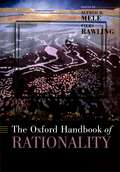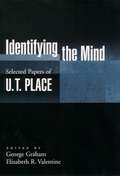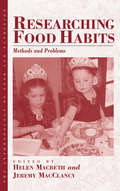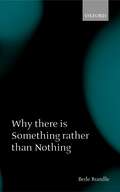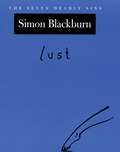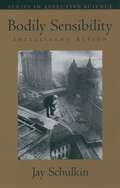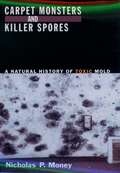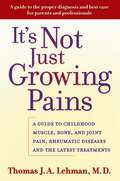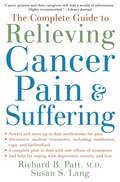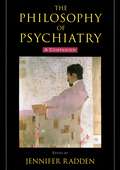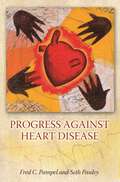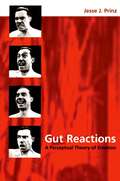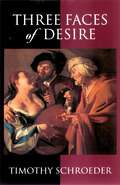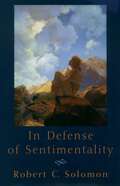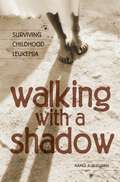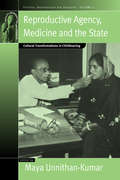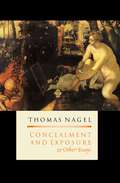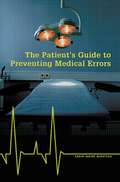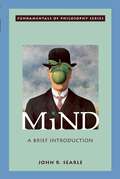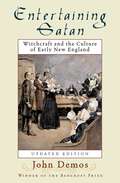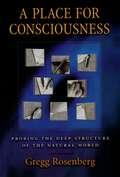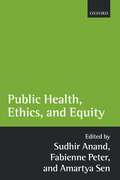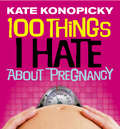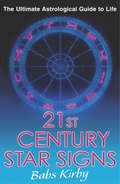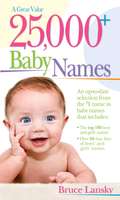- Table View
- List View
The Oxford Handbook of Rationality (Oxford Handbooks)
by Alfred R. Mele Piers RawlingRationality has long been a central topic in philosophy, crossing standard divisions and categories. It continues to attract much attention in published research and teaching by philosophers as well as scholars in other disciplines, including economics, psychology, and law. The Oxford Handbook of Rationality is an indispensable reference to the current state of play in this vital and interdisciplinary area of study. Twenty-two newly commissioned chapters by a roster of distinguished philosophers provide an overview of the prominent views on rationality, with each author also developing a unique and distinctive argument.
Identifying the Mind: Selected Papers of U. T. Place (Philosophy of Mind)
by the late U. T. PlaceThis is the one and only book by the pioneer of the identity theory of mind. The collection focuses on Place's philosophy of mind and his contributions to neighboring issues in metaphysics and epistemology. It includes an autobiographical essay as well as a recent paper on the function and neural location of consciousness.
Researching Food Habits: Methods and Problems (Anthropology of Food & Nutrition #5)
by Helen Macbeth Jeremy MacClancyThe term 'Anthropology of Food' has become an accepted abbreviation for the study of anthropological perspectives on food, diet and nutrition, an increasingly important subdivision of anthropology that encompasses a rich variety of perspectives, academic approaches, theories, and methods. Its multi-disciplinary nature adds to its complexity. This is the first publication to offer guidance for researchers working in this diverse and expanding field of anthropology.
Why There Is Something Rather Than Nothing
by Bede RundleWhy should there be anything at all? Why, in particular, should a material world exist? Bede Rundle advances clear, non-technical answers to these perplexing questions. If, as the theist maintains, God is a being who cannot but exist, his existence explains why there is something rather than nothing. However, this can also be explained on the basis of a weaker claim. Not that there is some particular being that has to be, but simply that there has to be something or other. Rundle proffers arguments for thinking that that is indeed how the question is to be put to rest. Traditionally, the existence of the physical universe is held to depend on God, but the theist faces a major difficulty in making clear how a being outside space and time, as God is customarily conceived to be, could stand in an intelligible relation to the world, whether as its creator or as the author of events within it. Rundle argues that a creator of physical reality is not required, since there is no alternative to its existence. There has to be something, and a physical universe is the only real possibility. He supports this claim by eliminating rival contenders; he dismisses the supernatural, and argues that, while other forms of being, notably the abstract and the mental, are not reducible to the physical, they presuppose its existence. The question whether ultimate explanations can ever be given is forever in the background, and the book concludes with an investigation of this issue and of the possibility that the universe could have existed for an infinite time. Other topics discussed include causality, space, verifiability, essence, existence, necessity, spirit, fine tuning, and laws of Nature. Why There Is Something Rather Than Nothing offers an explanation of fundamental facts of existence in purely philosophical terms, without appeal either to theology or cosmology. It will provoke and intrigue anyone who wonders about these questions.
Lust: The Seven Deadly Sins (New York Public Library Lectures in Humanities)
by Simon BlackburnLust, says Simon Blackburn, is furtive, headlong, always sizing up opportunities. It is a trail of clothing in the hallway, the trashy cousin of love. But be that as it may, the aim of this delightful book is to rescue lust "from the denunciations of old men of the deserts, to deliver it from the pallid and envious confessor and the stocks and pillories of the Puritans, to drag it from the category of sin to that of virtue." Blackburn, author of such popular philosophy books as Think and Being Good, here offers a sharp-edged probe into the heart of lust, blending together insight from some of the world's greatest thinkers on sex, human nature, and our common cultural foibles. Blackburn takes a wide ranging, historical approach, discussing lust as viewed by Aristophanes and Plato, lust in the light of the Stoic mistrust of emotion, and the Christian fear of the flesh that catapulted lust to the level of deadly sin. He describes how philosophical pessimists like Schopenhauer and Sartre contributed to our thinking about lust and explores the false starts in understanding lust represented by Freud, Kinsey, and modern "evolutionary psychology." But most important, Blackburn reminds us that lust is also life-affirming, invigorating, fun. He points to the work of David Hume (Blackburn's favorite philosopher) who saw lust not only as a sensual delight but also "a joy of the mind." Written by one of the most eminent living philosophers, attractively illustrated and colorfully packaged, Lust is a book that anyone would lust over.
Bodily Sensibility: Intelligent Action (Series in Affective Science)
by Jay SchulkinAlthough we usually identify our abilities to reason, to adapt to situations, and to solve problems with the mind, recent research has shown that we should not, in fact, detach these abilities from the body. This work provides an integrative framework for understanding how these abilities are affected by visceral reactions. Schulkin presents provocative neuroscientific research demonstrating that thought is not on one side and bodily sensibility on the other; from a biological point of view, they are integrated. Schulkin further argues that this integration has important implications for judgements about art and music, moral sensibilities, attraction and revulsion, and our perpetual inclination to explain ourselves and our surroundings.
Carpet Monsters and Killer Spores: A Natural History of Toxic Mold
by Nicholas P. MoneyMolds are everywhere: we inhale their microscopic spores from birth to death. But when an investigation in Ohio revealed that babies suffering from a serious lung illness had been exposed to a toxic black mold in their homes, millions of Americans became nervous about patches of mold in their own basements and bathrooms. Before long, lawsuits were filed by the residents of mold-contaminated homes in every state. By failing to address water damage, building contractors, plumbers, and insurance agents were held liable for exposing families to an unprecedented microbiological hazard. The mold crisis soon developed into a fully-fledged media circus. In Carpet Monsters and Killer Spores, Nicholas Money explores the science behind the headlines and courtroom dramas, and profiles the toxin-producing mold that is a common inhabitant of water-damaged buildings. Nicholas Money tells the most important mycological story since potato blight, with his inimitable style of scientific clarity and dark humor.
It's Not Just Growing Pains: A Guide to Childhood Muscle, Bone, and Joint Pain, Rheumatic Diseases, and the Latest Treatments
by Thomas J. LehmanArthritis is usually considered a disease of older adults, but nearly 300,000 children in the United States suffer from some form of arthritis or rheumatic disease, such as juvenile arthritis (JRA), fibromyalgia, chronic fatigue, systemic lupus erythematosus, scleroderma, or Kawasaki disease. Yet until now very little information has been available to guide parents and doctors in properly diagnosing such children. Here is a readable, reliable guide to the common causes of bone, joint, muscle, and arthritis pain in children, designed to help parents and physicians understand these disorders, arrive at the proper diagnosis, and choose the most effective treatment. In this comprehensive resource, Dr. Thomas Lehman--the head of one of the most prestigious pediatric rheumatology programs in the world--offers easy-to-understand information on the causes, symptoms, tests, and treatments for a wide variety of rheumatic diseases and childhood pain. Dr. Lehman writes with great clarity, providing numerous case examples that illustrate the topic at hand and offering practical, down-to-earth advice. Equally important, he answers the questions that parents are most likely to ask: What should they observe in their children? What questions should they ask their doctor? Which tests are necessary? What risk factors should they be aware of? And how can they help their children cope with the social and psychological aspects of their illness. The book summarizes diagnostic tests, discusses the most effective medications, and discusses physical therapy, alternative therapy, and surgical options that are available. Clearly written, thorough, authoritative, and up-to-date, It's Not Just Growing Pains is the definitive resource available on the subject for parents and health care professionals, helping them to understand the children's pain and find the best available care.
The Complete Guide to Relieving Cancer Pain and Suffering
by Richard B. Patt Susan S. LangMost cancer patients fear unremitting pain more than the prospect of an untimely death, and are surprised to learn that most of the pain and related symptoms of cancer can be successfully addressed by an informed patient working with a determined health care team. Thoroughly updating their widely praised 1994 book, You Don't Have to Suffer, Dr. Richard B. Patt and Susan Lang offer a much-needed handbook for patients and caregivers on all aspects of cancer pain and suffering. The authors identify the reasons why patients are so often under-medicated--from patients who feel the need to tough it out to doctors buried in time-consuming paperwork--and argue that properly medicated patients are better able to resume active lives and marshal strength to fight their disease. Those in chronic pain not only suffer, but also jeopardize their recovery. They demonstrate methods that can be used to cope with pain, nausea, constipation, fatigue, and other symptoms related to cancer and cancer treatment, and describe all of the pain-relieving options available in the modern medical arsenal. This includes drugs and high-tech medical procedures, as well as psychological, cognitive, and mind/body techniques. The authors also discuss depression and other psychological components that can contribute to suffering, as well as end-of-life issues. The book includes detailed charts of all the pain medications presently available and lists many available resources, from pain specialists to hospice and home care. This book will empower cancer patients and their families to make informed decisions about their care and will be of enormous value to the growing number of patients, family members, and health-care professionals determined to relieve needless suffering.
The Philosophy of Psychiatry: A Companion (International Perspectives in Philosophy and Psychiatry)
by Jennifer RaddenThis is a comprehensive resource of original essays by leading thinkers exploring the newly emerging inter-disciplinary field of the philosophy of psychiatry. The contributors aim to define this exciting field and to highlight the philosophical assumptions and issues that underlie psychiatric theory and practice, the category of mental disorder, and rationales for its social, clinical and legal treatment. As a branch of medicine and a healing practice, psychiatry relies on presuppositions that are deeply and unavoidably philosophical. Conceptions of rationality, personhood and autonomy frame our understanding and treatment of mental disorder. Philosophical questions of evidence, reality, truth, science, and values give meaning to each of the social institutions and practices concerned with mental health care. The psyche, the mind and its relation to the body, subjectivity and consciousness, personal identity and character, thought, will, memory, and emotions are equally the stuff of traditional philosophical inquiry and of the psychiatric enterprise. A new research field--the philosophy of psychiatry--began to form during the last two decades of the twentieth century. Prompted by a growing recognition that philosophical ideas underlie many aspects of clinical practice, psychiatric theorizing and research, mental health policy, and the economics and politics of mental health care, academic philosophers, practitioners, and philosophically trained psychiatrists have begun a series of vital, cross-disciplinary exchanges. This volume provides a sampling of the research yield of those exchanges. Leading thinkers in this area, including clinicians, philosophers, psychologists, and interdisciplinary teams, provide original discussions that are not only expository and critical, but also a reflection of their authors' distinctive and often powerful and imaginative viewpoints and theories. All the discussions break new theoretical ground. As befits such an interdisciplinary effort, they are methodologically eclectic, and varied and divergent in their assumptions and conclusions; together, they comprise a significant new exploration, definition, and mapping of the philosophical aspects of psychiatric theory and practice.
Progress against Heart Disease
by Fred C. Pampel Seth PauleyIn the last 35 years, declining deaths from heart disease have translated into 13 million lives saved and extended. Medical treatments and lifestyle changes have dealt successfully with the serious heart problems of Vice President Richard Cheney, talk show host David Letterman, Disney-ABC CEO Michael Eisner, and countless other less famous people. In the past, those with serious heart disease would have died young, but today can live long and active lives. Few families have not benefited from improvements in the way we treat and prevent heart problems, yet we often hear that poor lifestyles and the limitations of modern medicine threaten our health and well-being. Although room for improvement always remains, this book provides evidence to the contrary: we have made and continue to make tremendous progress in dealing with heart disease.In reviewing the progress being made in this crucially important area of health, Pampel and Pauley offer an optimistic view of the potential for continued improvement and for longer, healthier lives. Despite the prevalence of heart disease, deaths from this cause have declined greatly in past decades. From its peak in 1968, the heart disease mortality rate has fallen by 52% for men and 48% for women. That translates into over 13 million lives saved and extended. The lives saved are not limited to the very old. To the contrary, heart disease mortality has fallen faster among the young and middle aged.
Gut Reactions: A Perceptual Theory of Emotion (Philosophy of Mind)
by Jesse J. PrinzGut Reactions is an interdisciplinary defense of the claim that emotions are perceptions in a double sense. First of all, they are perceptions of changes in the body, but, through the body, they also allow us to literally perceive danger, loss, and other matters of concern. This proposal, which Prinz calls the embodied appraisal theory, reconciles the long standing debate between those who say emotions are cognitive and those who say they are noncognitive. The basic idea behind embodied appraisals is captured in the familiar notion of a "gut reaction," which has been overlooked by much emotion research. Prinz also addresses emotional valence, emotional consciousness, and the debate between evolutionary psychologists and social constructionists.
Three Faces of Desire (Philosophy of Mind)
by Timothy SchroederTo desire something is a condition familiar to everyone. It is uncontroversial that desiring has something to do with motivation, something to do with pleasure, and something to do with reward. Call these "the three faces of desire." The standard philosophical theory at present holds that the motivational face of desire presents its unique essence--to desire a state of affairs is to be disposed to act so as to bring it about. A familiar but less standard account holds the hedonic face of desire to reveal to true nature of desire. In this view, to desire something is to tend to pleasure if it seems that the desired state of affairs has been achieved, or displeasure if it seems otherwise, thus tying desire to feelings instead of actions. In Three Faces of Desire, Schroeder goes beyond actions and feelings to advance a novel and controversial theory of desire that puts the focus on desire's neglected face, reward. Informed by contemporary science as much as by the philosophical tradition, Three Faces of Desire discusses recent scientific discoveries that tell us much about the way that actions and feelings are produced in the brain. In particular, recent experiments reveal that a distinctive system is responsible for promoting action, on the one hand, and causing feelings of pleasure and displeasure, on the other. This system, the brain's reward system, is the causal origin of both action and feeling, and is the key to understanding the nature of desire.
In Defense of Sentimentality
by Robert C. SolomonPhilosophy has as much to do with feelings as it does with thoughts and thinking. Philosophy, accordingly, requires not only emotional sensitivity but an understanding of the emotions, not as curious but marginal psychological phenomena but as the very substance of life. In this, the second book in a series devoted to his work on the emotions, Robert Solomon presents a defense of the emotions and of sentimentality against the background of what he perceives as a long history of abuse in philosophy and social thought and art and literary criticism. The title piece reopens a classic debate about the role of sentimentality in art and literature. In subsequent chapters, Solomon discusses not only such "moral sentiments" as sympathy and compassion but also grief, gratitude, love, horror, and even vengeance. He also defends, with appropriate caution, the "seven deadly sins." The emotions, at least some emotions--are essential to a well-lived life. They are or can be virtues, features of the human condition without which civilized life would be unimaginable.
Walking with a Shadow: Surviving Childhood Leukemia
by Nanci A. SullivanChildhood cancer, particularly leukemia, is on the rise. Leukemia strikes one child in every 25,000, and most often does so between the ages of 3 and 7. Annually, more than 2,700 children are diagnosed with leukemia in the United States. Due to advances in biotechnology and medicine, survival rates for this once-deadly disease now stand at 80%. But the psychological effects of diagnosis, removal from school, treatment, and remission or cure, linger. Here nine long-term survivors of childhood leukemia share their vivid memories and give us insight into the physiological changes, psychosocial and educational difficulties that became a constant shadow in their lives. Author Nanci Sullivan provides recommendations for ways teachers, counselors and other professionals may better help young students with leukemia cope.
Reproductive Agency, Medicine and the State: Cultural Transformations in Childbearing (Fertility, Reproduction and Sexuality: Social and Cultural Perspectives #3)
by Maya Unnithan-KumarRecent years have seen many changes in human reproduction resulting from state and medical interventions in childbearing processes. Based on empirical work in a variety of societies and countries, this volume considers the relationship between reproductive processes (of fertility, pregnancy, childbirth and the postpartum period) on the one hand and attitudes, medical technologies and state health policies in diverse cultural contexts on the other.
Concealment and Exposure: And Other Essays
by Thomas NagelThomas Nagel is widely recognized as one of the top American philosophers working today. Reflecting the diversity of his many philosophical preoccupations, this volume is a collection of his most recent critical essays and reviews. The first section, Public and Private, focuses on the notion of privacy in the context of social and political issues, such as the impeachment of President Clinton. The second section, Right and Wrong, discusses moral, political and legal theory, and includes pieces on John Rawls, G.A. Cohen, and T.M. Scanlon, among others. The final section, Mind and Reality, features discussions of Richard Rorty, Donald Davidson, and the Sokal hoax, and closes with a substantial new essay on the mind-body problem. Written with characteristic rigor, these pieces reveal the intellectual passion underlying the incisive analysis for which Nagel is known.
The Patient's Guide to Preventing Medical Errors
by Karin J. BerntsenA nation watched in horror as 17-year-old Jessica Santillian died needlessly after a heart-lung transplant in 2003. She had been given organs with the wrong blood type. That error killed her. It is just one among tens of thousands of less publicized errors that occur in U.S. hospitals each year. Author Karin Berntsen, a veteran of the hospital and health care industry, takes us through the headlines, and the events never publicized, into hospital wards and surgical rooms to see how errors are made causing disability or death. She gives graphic examples of actual events that illustrate the problems cited in a federal Institute of Medicine report showing medical errors in the hospital cause 44,000 to 98,000 deaths each year. Those errors include medication mistakes, wrong site or side surgery, and botched transfusions. Berntsen explains why these are not just human errors with one or two people responsible; they are systems failures that require a major culture change to remedy. And that change, she argues, may not come without action by the very people the medical system is designed to help: patients. She offers clear actions consumers can take to assure they are not on the receiving end of a medical error. The book details over 200 tips for improving patient safety.U.S. hospitals have countless stories of miraculous healing and recovery; the greatest technology, most advanced medicines, and best research in the world. On the other hand, we have a system where medical errors bring more than 120 fatalities each day across the country in hospitals. An airline crash causing that many deaths daily would paralyze that industry. But because the deaths and harm are diluted across and deep within the silence of hospitals, it is easier to be complacent. There is, says Berntsen, an urgent need to pause and take inventory, a need for clinicians and consumers to come together as partners for change.
Mind: A Brief Introduction (Fundamentals of Philosophy Series)
by John R. Searle"The philosophy of mind is unique among contemporary philosophical subjects," writes John Searle, "in that all of the most famous and influential theories are false." One of the world's most eminent thinkers, Searle dismantles these theories as he presents a vividly written, comprehensive introduction to the mind. He begins with a look at the twelve problems of philosophy of mind--which he calls "Descartes and Other Disasters"--problems which he returns to throughout the volume, as he illuminates such topics as materialism, consciousness, the mind-body problem, intentionality, mental causation, free will, and the self. The book offers a refreshingly direct and engaging introduction to one of the most intriguing areas of philosophy.
Entertaining Satan: Witchcraft and the Culture of Early New England
by John Putnam DemosIn the first edition of the Bancroft Prize-winning Entertaining Satan, John Putnam Demos presented an entirely new perspective on American witchcraft. By investigating the surviving historical documents of over a hundred actual witchcraft cases, he vividly recreated the world of New England during the witchcraft trials and brought to light fascinating information on the role of witchcraft in early American culture. Now Demos has revisited his original work and updated it to illustrate why these early Americans' strange views on witchcraft still matter to us today. He provides a new preface that puts forth a broader overview of witchcraft and looks at its place around the world--from ancient times right up to the present.
A Place for Consciousness: Probing the Deep Structure of the Natural World (Philosophy of Mind)
by Gregg RosenbergWhat place does consciousness have in the natural world? If we reject materialism, could there be a credible alternative? In one classic example, philosophers ask whether we can ever know what is it is like for bats to sense the world using sonar. It seems obvious to many that any amount of information about a bat's physical structure and information processing leaves us guessing about the central questions concerning the character of its experience. A Place for Consciousness begins with reflections on the existence of this gap. Is it just a psychological shortcoming in our merely human understanding of the physical world? Is it a trivial consequence of the simple fact that we just cannot be bats? Or does it mean there really are facts about consciousness over and above the physical facts? If so, what does consciousness do? Why does it exist? Rosenberg sorts out these problems, especially those centering on the causal role of consciousness. He introduces a new paradigm called Liberal Naturalism for thinking about what causation is, about the natural world, and about how to create a detailed model to go along with the new paradigm. Arguing that experience is part of the categorical foundations of causality, he shows that within this new paradigm there is a place for something essentially like consciousness in all its traditional mysterious respects. A striking feature of Liberal Naturalism is that its central tenets are motivated independently of the mind-body problem, by analyzing causation itself. Because of this approach, when consciousness shows up in the picture it is not introduced in an ad hoc way, and its most puzzling features can be explained from first principles. Ultimately, Rosenberg's final solution gives consciousness a causally important role without supposing either that it is physical or that it interacts with the physical.
Public Health, Ethics, And Equity
by Sudhir Anand Fabienne Peter Amartya SenIn the last fifty years, average overall health status has increased more or less in parallel with a much celebrated decline in mortality, attributed mostly to poverty reduction, sanitation, nutrition, housing, immunization, and improved medical care. It is becoming increasingly clear, however, that these achievements were not equally distributed. In most countries, while some social groups have benefited significantly, the situation of others has stagnated or may even have worsened. If health is a prerequisite to a person functioning as an agent, inequalities in health constitute inequalities in people's capability to function — a denial of equality of opportunity. So why should a concern with health equity be singled out from the pursuit of social justice more generally? Can existing theories of justice provide an adequate account of health equity? And what ethical problems arise in evaluating health inequalities? These are some of the important questions that this book addresses in building an interdisciplinary understanding of health equity. With contributions from distinguished philosophers, anthropologists, economists, and public-health specialists, it centres on five major themes: what is health equity?; health equity and social justice; responsibilities for health; ethical issues in health evaluation; and anthropological perspectives.
100 Things I Hate About Pregnancy: What You'll Detest When You're Expecting
by Kate KonopickyThough a very special time for every woman, pregnancy can be pretty stressful, and unless you've been there it's hard to appreciate what a woman is going through. In this hilarious book Kate Konopicky lists 100 things that she hated when she was pregnant, from baby on board badges ('Not funny. Just twee.'), to jokes about cravings ('No I don't want a piece of coal for my lunch and I haven't eaten the potting compost') , dropping food on your stomach, the fact that HE'S not pregnant, having to decorate the nursery, maternity bras and horrible baby stationery.
21st Century Star Signs: The Ultimate Astrological Guide To Life
by Babs KirbyEver wondered how best to win round a stubborn colleague, or why it is you can never settle for just one partner? Babs Kirby's 21st Century Star Signs will tell you everything you ever wanted to know about you, your lover, father, daughter , boss and even today's A-list celebrities, in this, the most modern, in-depth astrological portrait for the 21st century. Taking up where the massive bestseller Linda Goodman's Sun Signs left off, Babs takes a completely contemporary, zeitgeisty approach that's compassionate, intelligent and, above all, revealing.21st Century Star Signs reflects and embraces today's sensibilities and values looking at the way we function in sexual relationships - whether they're heterosexual, metrosexual, gay (or otherwise-), in work - with all it's ever-changing technologies and opportunities and in our homelife in which single parents, serial monogomists and stay-at-home fathers are now the norm. A chapter is dedicated to each sign, giving an in-depth portrait which will reveal every aspect of the sign including both positive and negative aspects, bringing hidden motivations, sexual proclivities and characteristics to the fore and showing how different signs will thrive under certain circumstance, how to nurture one's positive influences and how best to recognise, relate to and deal with other signs -with all their strengths and weaknesses.
25,000+ Baby Names
by Bruce LanskySelect the perfect name for your new baby!Not sure what to name your child? Torn between a traditional family name and an up-and-coming name? Or maybe you don't even know where to start? Let 25,000+ Baby Names be your guide to finding the right name! This book lets you easily scan boys' and girls' names and includes features like: guidelines for naming your baby, popular names from around the world, origins, meanings, famous namesakes, and interesting name trivia.Sample Girl's Name (including: name, origin, meaning, cross-referencing, and variations/nicknames): "Katherine * (Greek) pure. See also Carey, Catherine, Ekaterina, Kara, Karen, Kari, Kasia, Katerina, Yekaterina. Ekatrinna, Kasienka, Kasin, Kat, Katchen, Kathann, Kathanne, Kathereen, Katheren, Katheren, Katherenne, Katherin, Katherina, Katheryn, Katheryne, Kathyrine, Katina, Katlaina, Katoka, Katreeka." Sample Boy's Name (including: name, origin, meaning, famous namesake, and variations/nicknames): "Noah * (Hebrew) peaceful, restful. Bible: the patriarch who built the ark to survive the Flood. Noak, Noi."
